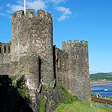CAERNARFON
CASTLE
Prince of Wales and the Royal Fusiliers
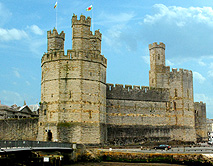
The eldest son of Britain’s monarch and first in line to the English throne usually receives the title of the Prince of Wales. This has been the case since King Edward I occupied Wales in 1283 and built his famous “Iron Ring” of castles. As a concession to the Celtic Welsh, the first Edward promised that his first son would be born in Wales. This bit of political PR went a good way toward getting the Welsh to accept the English rule, though they couldn’t do a lot else about it. A deft move as the iron-fisted English king called “Longshanks” was at the time constructing his first castle at Caernarfon (more common now than the anglicized Caernarvon), the ancient town at the mouth of the Menai Straits where the River Seint enters from the Irish Sea and separates the North Wales mainland from the isle of Anglesey. Edward happened to be resident at the construction and his wife was pregnant.
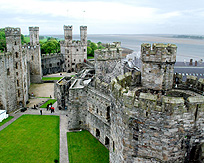 Caernarfon Castle is the most prominent feature of the ancient town which had been the site of fortresses protecting the best port of the north since even before the Romans came, and was the capital of the Celtic Princes of Gwynedd before being permanently annexed by the Norman Plantagenets. Edward II, called Edward of Caernarvon was the first Prince of Wales, born at the castle, later to be infamously murdered at Berkeley Castle in Gloustershire (see Berkeley Castle Edward Chamber). Edward VIII was invested as Prince of Wales at Caernarfon in 1911 (see Ruthin
Castle) as well as the current Prince Charles, whose televised
investiture in 1969 by his mother Queen Elizabeth brought both the castle
Caernarfon Castle is the most prominent feature of the ancient town which had been the site of fortresses protecting the best port of the north since even before the Romans came, and was the capital of the Celtic Princes of Gwynedd before being permanently annexed by the Norman Plantagenets. Edward II, called Edward of Caernarvon was the first Prince of Wales, born at the castle, later to be infamously murdered at Berkeley Castle in Gloustershire (see Berkeley Castle Edward Chamber). Edward VIII was invested as Prince of Wales at Caernarfon in 1911 (see Ruthin
Castle) as well as the current Prince Charles, whose televised
investiture in 1969 by his mother Queen Elizabeth brought both the castle
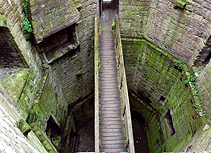 The castle at Caernarfon is a large powerful structure of light colored stone, long and narrow, of high walls with three prominent defensive towers, the Black Tower, the Chamberlain's Tower, and the Eagle Tower, with distinctive angles of octogonal shape rather than the round towers of Conwy or square Norman keeps like Kenilworth (see Kenilworth
Castle or Hedingham
Castle),
said to be inspired by Edward's Crusade trip to Constantinople. The angles can be closely examined in the Well Tower, with high the
The castle at Caernarfon is a large powerful structure of light colored stone, long and narrow, of high walls with three prominent defensive towers, the Black Tower, the Chamberlain's Tower, and the Eagle Tower, with distinctive angles of octogonal shape rather than the round towers of Conwy or square Norman keeps like Kenilworth (see Kenilworth
Castle or Hedingham
Castle),
said to be inspired by Edward's Crusade trip to Constantinople. The angles can be closely examined in the Well Tower, with high the 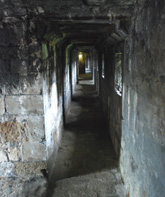 wooden bridges leading to long passageways through the stone walls. The castle is mostly what remains of the last major construction in 1323, and was never actually completed. Edward I and his Queen Eleanor preferred Conwy Castle for their Wales residence (see Conwy
Castle). The walls can be climbed through quite narrow stairs on several levels to the battlements for high views of the inner bailey ward and the town and waters beyond. On any given day tour groups of students may be clamboring up and down like a medieval jungle gym. Outside the southwest Queen's Gate of the castle, intended as an upper entry across a drawbridge but never finished, stands a statue of David Lloyd George, Prime Minister of Britain during WWI who represented Caernarfon in the House of Commons.
wooden bridges leading to long passageways through the stone walls. The castle is mostly what remains of the last major construction in 1323, and was never actually completed. Edward I and his Queen Eleanor preferred Conwy Castle for their Wales residence (see Conwy
Castle). The walls can be climbed through quite narrow stairs on several levels to the battlements for high views of the inner bailey ward and the town and waters beyond. On any given day tour groups of students may be clamboring up and down like a medieval jungle gym. Outside the southwest Queen's Gate of the castle, intended as an upper entry across a drawbridge but never finished, stands a statue of David Lloyd George, Prime Minister of Britain during WWI who represented Caernarfon in the House of Commons.
Royal Welch Fusiliers Museum
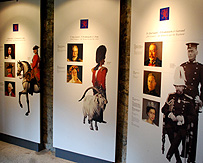 The former residential chambers of the castle (though never really occupied by royals since the 14th Century) now houses the Royal Welch Fusiliers Museum. The military museum is dedicated to the famed regiment first formed in 1689 under William III, fighting in the campaigns of the Duke of Marlborough (see Blenheim
Palace), the American Revolution, the Crimean and Boer Wars, facing Napoleon at Waterloo (see Waterloo
Museums), two
world wars and Bosnia.
The former residential chambers of the castle (though never really occupied by royals since the 14th Century) now houses the Royal Welch Fusiliers Museum. The military museum is dedicated to the famed regiment first formed in 1689 under William III, fighting in the campaigns of the Duke of Marlborough (see Blenheim
Palace), the American Revolution, the Crimean and Boer Wars, facing Napoleon at Waterloo (see Waterloo
Museums), two
world wars and Bosnia.
Old Caernarfon
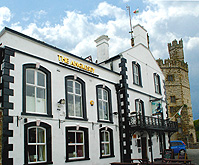 The
old town of Caernarfon was surrounded by walls after Edward I fortified
his castle. The buildings in the old town are mostly from the early
19th Century. The walls carry all along the waterfront and remain
nealy intact
except where the city street passes around the castle, completely
encasing the historic village. The castle and city walls of Caernarfon,
along
with the the castles at Beaumaris, Conwy and Harlech together form
a UNESCO World Heritage site. Almost everywhere around the town of
Caernafon
you’ll hear the lilt of Welsh being spoken, as the language
and the Celtic heritage of this unique part of Britain is being rediscovered
and embraced. Caernarfon makes for a good base to explore the rugged
peaks of Snowdonia and sandy beaches of North Wales, with activities
from golfing, mountain hiking and biking, to ocean fishing and sailing.
Hotels in the village of Caernarfon range from the Royal
Celtic Hotel (Gwesty R Celt) complete with spa, the Black
Boy Inn idating back to the 16th Century inside the village walls,
to the pub with rooms style of The Anglesey Arms, nestled against
the city walls
on
the harbor
quay.
The
old town of Caernarfon was surrounded by walls after Edward I fortified
his castle. The buildings in the old town are mostly from the early
19th Century. The walls carry all along the waterfront and remain
nealy intact
except where the city street passes around the castle, completely
encasing the historic village. The castle and city walls of Caernarfon,
along
with the the castles at Beaumaris, Conwy and Harlech together form
a UNESCO World Heritage site. Almost everywhere around the town of
Caernafon
you’ll hear the lilt of Welsh being spoken, as the language
and the Celtic heritage of this unique part of Britain is being rediscovered
and embraced. Caernarfon makes for a good base to explore the rugged
peaks of Snowdonia and sandy beaches of North Wales, with activities
from golfing, mountain hiking and biking, to ocean fishing and sailing.
Hotels in the village of Caernarfon range from the Royal
Celtic Hotel (Gwesty R Celt) complete with spa, the Black
Boy Inn idating back to the 16th Century inside the village walls,
to the pub with rooms style of The Anglesey Arms, nestled against
the city walls
on
the harbor
quay.
Visiting Caernavon Castle Wales
If visiting by car there is a pay and display parking lot beside
the castle. Admission for adults is £6.75, students and seniors £5.10, with a family ticket
available for £20.25. Admission includes the Welch Fusiliers
Museum. The castle is open year around, 9:30 am to 5pm from March to June and September-October, 9:30am to 6pm July and August, and 10am
to 4 pm November through February (11am to 4pm on Sundays in winter).
By rail, the nearest train station is at Bangor on the Crewe-Bangor-Holyhead
route served by Britrail and Virgin, with a 10 mile bus ride to
Caernarfon.
By bus even as far as Heathrow, the National
Express bus
line serves Caernarfon with direct service. Caernarfon is about
4.5 hours from
London by train and 5 hours by car.
For a scenic rail ride, the Caernarfon station of the Ffestiniog & Welsh
Highland Railway is right next to the castle, operating a scenic
steam train which runs on a 19 mile scenic journey from Caernarfon
climbing
across the slopes of Mount Snowdon. © Bargain
Travel Europe
Compare best hotel deals in North Wales on TripAdvisor
Web Info
Caernarfon
Cadw
These articles are copyrighted and the sole property of Bargain Travel Europe and WLPV, LLC. and may not be copied or reprinted without permission.
SEE ALSO:
SNOWDONIA STEAM RAILWAYS - PORTHMADOG
HARLECH
CASTLE
BEAUMARIS
CASTLE
LLANGOLLEN
STEAM RAILWAY

